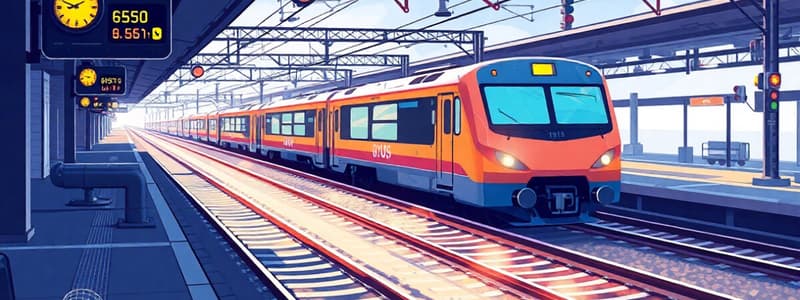Podcast
Questions and Answers
What must a Driver do when they see a red aspect displayed on a signal?
What must a Driver do when they see a red aspect displayed on a signal?
- Continue without stopping if the line is clear
- Pass the signal at maximum speed
- Wait for a Written Order or Track Movement Authority to pass (correct)
- Proceed, but reduce speed to half
What does a green aspect on a colour light signal indicate?
What does a green aspect on a colour light signal indicate?
- Driver may pass at no more than the permitted maximum speed (correct)
- Train should reduce speed to a quarter
- Next signal must be checked before proceeding
- Train must stop and check for clear line
What is the responsibility of the Person Controlling Train Movements?
What is the responsibility of the Person Controlling Train Movements?
- To directly drive the train and issue orders
- To observe lineside markers and signals during shunting movements (correct)
- Only to operate the train at designated speeds
- To manage train schedules while ignoring signs
What does a Limit of Shunt board indicate?
What does a Limit of Shunt board indicate?
What should a Driver do upon encountering a Stop Board?
What should a Driver do upon encountering a Stop Board?
What is the purpose of ERTMS Marker Boards?
What is the purpose of ERTMS Marker Boards?
Which action is NOT permitted when encountering a Calling On aspect?
Which action is NOT permitted when encountering a Calling On aspect?
What color does the triangle on the ERTMS Marker Board point towards?
What color does the triangle on the ERTMS Marker Board point towards?
Which statement about Ground Staff is accurate?
Which statement about Ground Staff is accurate?
What should a Driver do if they see a Limit of Shunt board during operations?
What should a Driver do if they see a Limit of Shunt board during operations?
What must the Driver immediately do if the ERTMS equipment fails to transition when entering an ERTMS area?
What must the Driver immediately do if the ERTMS equipment fails to transition when entering an ERTMS area?
If the ERTMS equipment fails to transition to level 0, what is the first action the Driver must take?
If the ERTMS equipment fails to transition to level 0, what is the first action the Driver must take?
What action should the Train Controller take immediately upon learning of an ERTMS system failure reported by a Driver?
What action should the Train Controller take immediately upon learning of an ERTMS system failure reported by a Driver?
How should the Train Controller respond if they notice a train has failed to transition without being notified by the Driver?
How should the Train Controller respond if they notice a train has failed to transition without being notified by the Driver?
When a Driver identifies a signalling system failure, what is their immediate responsibility?
When a Driver identifies a signalling system failure, what is their immediate responsibility?
What should the Driver do if a signal or Marker Board becomes difficult to see?
What should the Driver do if a signal or Marker Board becomes difficult to see?
If the Driver reports an ERTMS signalling failure, what is the responsible action for the Train Controller?
If the Driver reports an ERTMS signalling failure, what is the responsible action for the Train Controller?
What must the Train Controller do before issuing a Written Order?
What must the Train Controller do before issuing a Written Order?
What is the consequence if a train fails to transition and the Driver does not report it to the Train Controller?
What is the consequence if a train fails to transition and the Driver does not report it to the Train Controller?
Who is responsible for reporting signalling failures during shunting movements?
Who is responsible for reporting signalling failures during shunting movements?
What must be done before a train can operate in Shunt mode?
What must be done before a train can operate in Shunt mode?
What does a Level 0 Board signify?
What does a Level 0 Board signify?
What is a characteristic of the Full Supervision (FS) Movement Authority?
What is a characteristic of the Full Supervision (FS) Movement Authority?
What information does the DMI display provide to the driver?
What information does the DMI display provide to the driver?
Which scenario allows the driver to operate a train without a Movement Authority?
Which scenario allows the driver to operate a train without a Movement Authority?
What does a Turnout Position Indicator show?
What does a Turnout Position Indicator show?
What occurs during ‘On Sight Received in Transit’?
What occurs during ‘On Sight Received in Transit’?
What is indicated by the solid diagonal line in a Turnout Position Indicator?
What is indicated by the solid diagonal line in a Turnout Position Indicator?
When must the authority to move the train be obtained during a shunt operation?
When must the authority to move the train be obtained during a shunt operation?
What do Clearance Markers prevent?
What do Clearance Markers prevent?
Under what circumstances may Staff Responsible be used?
Under what circumstances may Staff Responsible be used?
What must be confirmed before a train enters an ERTMS area?
What must be confirmed before a train enters an ERTMS area?
What action must you take if your train is signaled for a wrong route?
What action must you take if your train is signaled for a wrong route?
What should be done when approaching an End of Authority where the Marker Board is missing?
What should be done when approaching an End of Authority where the Marker Board is missing?
Which condition must be fulfilled before transitioning out of an ERTMS fitted area?
Which condition must be fulfilled before transitioning out of an ERTMS fitted area?
What is the procedure if a Movement Authority is withdrawn while the train is moving?
What is the procedure if a Movement Authority is withdrawn while the train is moving?
When is it permissible to move a train without authority or supervision?
When is it permissible to move a train without authority or supervision?
What must a Driver do if they stop the train at an End of Authority after an MA was issued?
What must a Driver do if they stop the train at an End of Authority after an MA was issued?
What happens when a train approaches a Level 2 ERTMS area?
What happens when a train approaches a Level 2 ERTMS area?
Which of the following actions is NOT required before entering an ERTMS area?
Which of the following actions is NOT required before entering an ERTMS area?
Flashcards
Marker Board
Marker Board
A visual trackside indication that shows the limit up to which a train, locomotive, or On Track Machine (OTM) can be given authority to move with a Movement Authority (MA), written order, Track Movement Authority (TMA), or On Track Machine Protection (OTMP). Each board has a unique name plate.
Limit of Shunt Board
Limit of Shunt Board
A visual trackside indication that drivers must observe during shunting movements and take appropriate action. They indicate the limit for forward movements.
Colour Light Signals
Colour Light Signals
Provide visual trackside indications of locations where trains are expected to enter and exit ETCS Level 2 Full Supervision. Each signal has a unique identity.
Sign Board (Stop Board)
Sign Board (Stop Board)
Signup and view all the flashcards
Color Light Signals - Green Aspect
Color Light Signals - Green Aspect
Signup and view all the flashcards
Color Light Signals - Red Aspect
Color Light Signals - Red Aspect
Signup and view all the flashcards
Color Light Signals - Calling On Aspect
Color Light Signals - Calling On Aspect
Signup and view all the flashcards
Driver
Driver
Signup and view all the flashcards
Ground Staff & Personnel Who Control Train Movements
Ground Staff & Personnel Who Control Train Movements
Signup and view all the flashcards
Person Controlling Train Movements
Person Controlling Train Movements
Signup and view all the flashcards
Limit of Shunt (Propelling) Board
Limit of Shunt (Propelling) Board
Signup and view all the flashcards
Level Transition Board
Level Transition Board
Signup and view all the flashcards
Level 2 Board
Level 2 Board
Signup and view all the flashcards
Level 0 Board
Level 0 Board
Signup and view all the flashcards
Identification Plate (ID Plate)
Identification Plate (ID Plate)
Signup and view all the flashcards
Turnout Position Indicator
Turnout Position Indicator
Signup and view all the flashcards
Clearance Marker
Clearance Marker
Signup and view all the flashcards
Driver Machine Interface (DMI)
Driver Machine Interface (DMI)
Signup and view all the flashcards
Full Supervision (FS)
Full Supervision (FS)
Signup and view all the flashcards
On Sight (OS)
On Sight (OS)
Signup and view all the flashcards
Staff Responsible Circumstances
Staff Responsible Circumstances
Signup and view all the flashcards
Standby (SB)
Standby (SB)
Signup and view all the flashcards
Unfitted (UN)
Unfitted (UN)
Signup and view all the flashcards
Entering an ERTMS area (Driver Responsibility)
Entering an ERTMS area (Driver Responsibility)
Signup and view all the flashcards
Level 2 ERTMS Area Transition
Level 2 ERTMS Area Transition
Signup and view all the flashcards
Non-ERTMS Area Movement
Non-ERTMS Area Movement
Signup and view all the flashcards
Exiting an ERTMS area
Exiting an ERTMS area
Signup and view all the flashcards
Stopping at an End of Authority (EOA) with Missing Marker Board
Stopping at an End of Authority (EOA) with Missing Marker Board
Signup and view all the flashcards
Withdrawing a Movement Authority (MA)
Withdrawing a Movement Authority (MA)
Signup and view all the flashcards
Handling a Withdrawn MA Without a Known Reason
Handling a Withdrawn MA Without a Known Reason
Signup and view all the flashcards
ERTMS Failure to Transition (Level 2)
ERTMS Failure to Transition (Level 2)
Signup and view all the flashcards
ERTMS Failure to Transition (Level 0)
ERTMS Failure to Transition (Level 0)
Signup and view all the flashcards
ERTMS Failure during Operation
ERTMS Failure during Operation
Signup and view all the flashcards
Reporting ERTMS Signalling Failure
Reporting ERTMS Signalling Failure
Signup and view all the flashcards
Reporting Damaged ERTMS Equipment
Reporting Damaged ERTMS Equipment
Signup and view all the flashcards
Obstructed ERTMS Equipment
Obstructed ERTMS Equipment
Signup and view all the flashcards
Train Controller Actions for ERTMS Failure
Train Controller Actions for ERTMS Failure
Signup and view all the flashcards
Reporting ERTMS Failures during Shunting
Reporting ERTMS Failures during Shunting
Signup and view all the flashcards
Reporting ERTMS Failures (Train Controller)
Reporting ERTMS Failures (Train Controller)
Signup and view all the flashcards
Written Order
Written Order
Signup and view all the flashcards
Study Notes
ERTMS Operational Procedures (OPS1)
- Driver Responsibilities: Drivers are responsible for observing all indications on the train and trackside signals, adhering to DMI (Driver Machine Interface) and trackside indications, except when rules require a lower speed
- Ground Staff Responsibilities: Ground staff monitoring shunting movements must observe all lineside markers, signs, and signals, taking appropriate action accordingly.
Signal Types and Indications
- Marker Boards: Locate points up to which trains can move, based on DMI, written orders, Track Movement Authority, or On-Track Machine Protection. Have unique identification plates. Yellow triangle points towards the line.
- Color Light Signals: Used where trains enter or exit ERTMS Level 2 Full Supervision. Display three aspects:
- Green: Proceed at permitted maximum speed (DMI or Train Controller authorized)
- Red: Do not proceed unless authorized by Train Controller (written order or Track Movement Authority)
- Calling On: Proceed, but the line ahead may not be clear. No further movement without a Movement Authority or Train Controller permission.
- Sign Boards (Stop Boards): Indicate locations where trains may not proceed without explicit Train Controller authorization or local operating instructions (yards/terminals/depots).
- Limit of Shunt Boards: Two types exist for forward and propelling shunting movements. These can only be passed with Train Controller authority.
- Level Transition Boards: Indicate locations where trains transition between ERTMS levels (Level 2 or Level 0). A Level 2 board signifies the commencement of level 2 operation, while a Level 0 board signifies the end.
- Identification Plates (ID Plates): Each signal, marker board, etc., has an ID plate with the Interlocking (IXL) number and specific identification of the equipment.
ERTMS Cab Signalling (OPS1.4)
- Driver Machine Interface (DMI): Displays vital information for safe train operation including permissible speed and Movement Authority distance. Additional information might come from trackside signs.
- Speed Control: Adhere to the speed indicated on the DMI. Don't exceed lower speeds enforced by technical constraints or rules.
- Movement Authorities (MAs):
- Full Supervision (FS): Normal MA, allowing maximum speed as defined in Network Operational Appendix, traction specific instructions, train documents or operating instructions. Lower speeds must be adhered to if required.
- On Sight (OS): Permits entry into an occupied section, allowing speed required to stop safely short of any obstruction ahead. Ceiling speeds and stopping distances are vital to this.
- On Sight (OS) In Transit: Train automatically supervised down to ceiling speed, warning displayed and acknowledged, brake intervention if not acknowledged.
- On Sight (OS) received at start of mission: Warning about on-sight mode is displayed; must be acknowledged by the driver or brake intervention will occur.
- Operating Modes:
- Shunt (SH): Used for shunting movements. Train controller authorization needed before and during a shunting movement. Passenger trains not permitted under shunt mode without specific authorization.
- Shunt Selected by Driver: Train must be stationary, shunt symbol not an authority to move, Train Controller authority is required.
- Shunt Ordered by System: Driver acknowledgment required, removes train data and terminates communications. Movement authorization from Train Controller is mandatory.
- Staff Responsible (SR): Used when a signaling system cannot provide a Movement Authority or if a train's position is invalid. Train Controller authority needed.
- Standby (SB): Automatically selected after successful self-test when opening the driver's desk.
- Unfitted (UN): Used when running on non-ERTMS lines. Only maximum design speed displayed on the DMI.
Entering/Exiting ERTMS Areas (OPS1.5, OPS1.6)
- Entering ERTMS area: ERTMS-fitted train needs working cab signalling equipment, or a Track Movement Authority. Validate on-train system, enter Driver ID and other data, and inform the Train Controller upon completing mission. Transition to Level 2 automatically once train passes the Level 2 Transition board, check the DMI, check for a valid Movement Authority. Movements on non ERTMS lines are managed by Track Movement Authority.
- Exiting ERTMS area: Automatic transition; acknowledge the warning of approaching transition. Observe the Level 0 Transition board, check that the DMI displays Level 0, and obey all lineside signals. Inform the Train Controller when the mission is complete.
- Exiting to terminal/siding: Local operating instructions apply.
End of Authority (EOA) (OPS1.7)
- Missing Marker Board: Stop at the location indicated by the DMI. Contact and inform the Train Controller.
- Unauthorized Movements: Do not move a train without ERTMS supervision or Train Controller authorization
Withdrawal of a Movement Authority (OPS1.8)
- Automatic Braking/Communication: if an MA is withdrawn, train will brake to a stand, communicate with the Train Controller to understand the reason and instructions. The process requires caution and communication. Train Controller must inform the driver if an MA is being withdrawn prior to actions.
- Train Controller Responsibilities: If a Train Controller removes an MA, they are required to ensure the driver is aware of this action before proceeding with it, except in emergencies or specific event handling modules that cover incidents like accidents or weather-related events
ERTMS Failures (OPS1.9)
- Transition Failures (Entering/Exiting): Ensure train stops, contact the Train Controller, and follow instructions. Train Controller resolves the issues and determines if a proceed or alternative mode is available.
- Running Failures: Automatic braking occurs when ERTMS equipment fails. Ensure to report the failure immediately for all cases and adhere to necessary instructions from the Train Controller.
- Signalling Equipment/Boards Failure: Report any damage, missing or unusual aspects of signals and lineside equipment immediately to the Train Controller
Written Orders (OPS1.10)
- Train Controller Responsibilities: Issue written orders if need for authority, for different scenarios such as continuing beyond EOA, caution, line inspections, or reduced-speed operation.
- Driver Responsibilities: Complete the written order dictated by Train Controller.
Studying That Suits You
Use AI to generate personalized quizzes and flashcards to suit your learning preferences.
Description
This quiz covers the operational procedures under ERTMS, focusing on the responsibilities of drivers and ground staff. It also explains various signal types and their indications, emphasizing how they guide train movements. Test your understanding of these critical aspects for safe and efficient railway operations.




